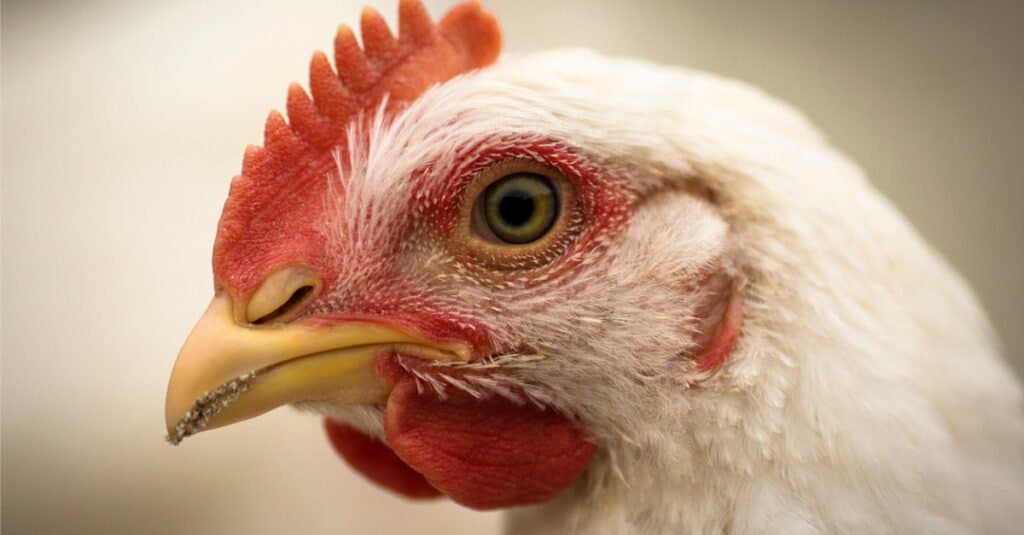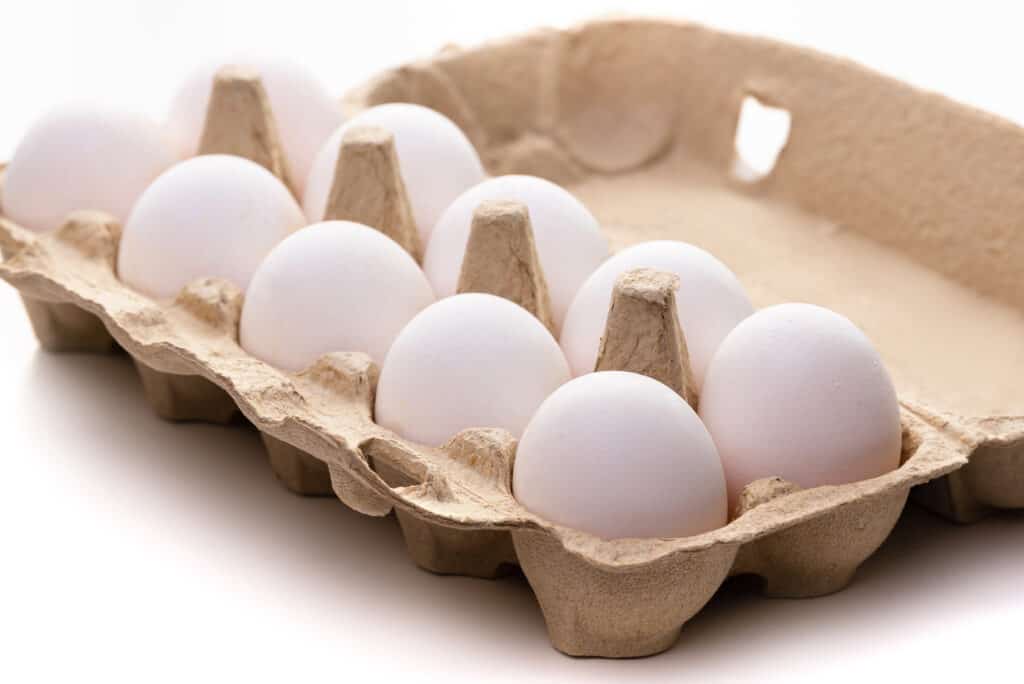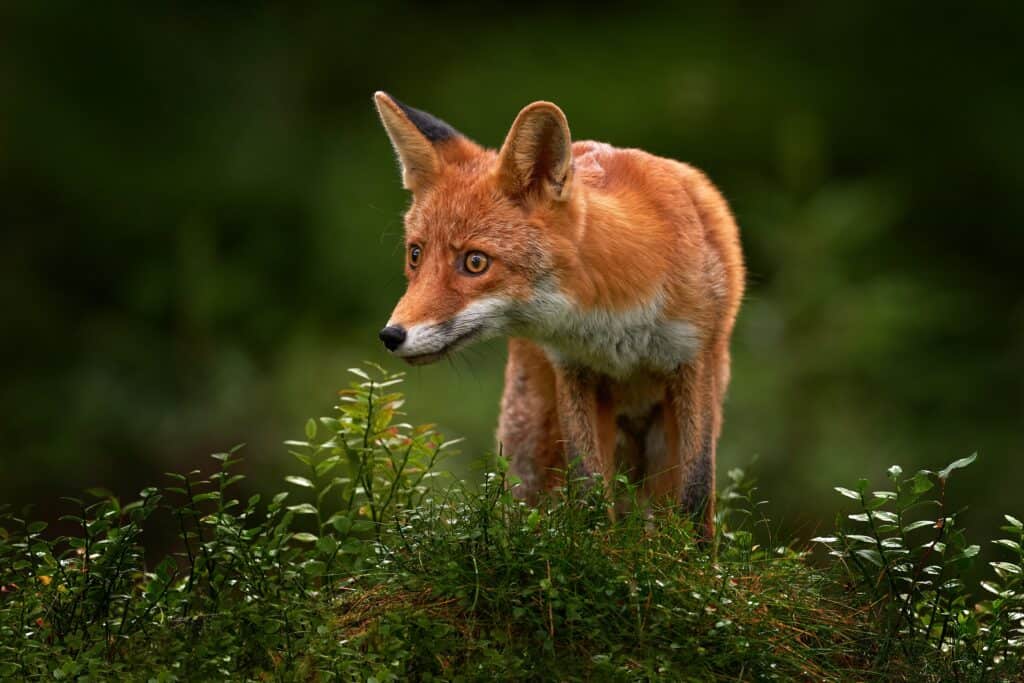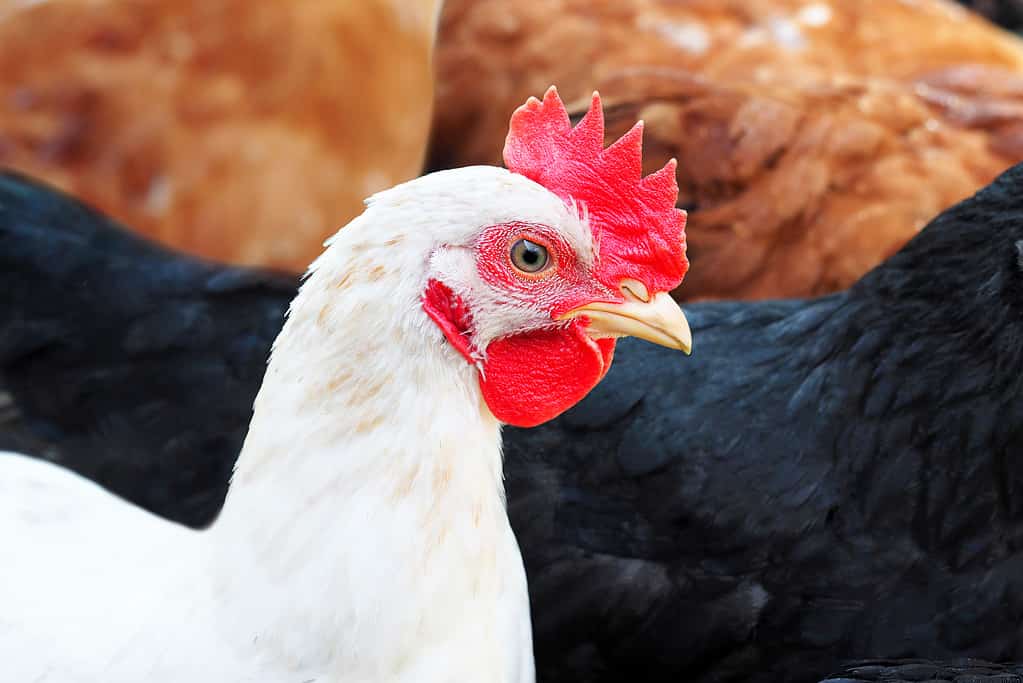Originally the ultimate dual-purpose bird, the Lamona chicken is a rare breed thought extinct in the 1980s. Only a few mysterious flocks remain today, so let’s learn more about the rare Lamona chicken, their origins, characteristics, prices, and much more.
Lamona Chicken: Origins

Lamona chickens were bred from white Leghorns, Plymouth Rocks, and silver-gray Dorkings.
©iStock.com/baiajaku
Poultry expert Harry S. Lamon developed Lamona chickens at the USDA’s experimental farm in Massachusetts between 1912 and 1933. He created what he considered a “super chicken” that could lay prolific amounts of white eggs and still taste good after it had finished laying. Most egg-laying chickens of the time had chewy, thin breast meat at the end of their laying days.
Lamon crossed White Leghorns, Plymouth Rocks, and silver-gray Dorkings. It took from 1912 to 1933 to perfect his super chicken, but in the final stages, Lamona chickens entered the American Poultry Association Standard of Perfection.
But these glory days didn’t last. By the 1980s, they had fallen out of fashion, replaced by the Cornish Rock for meat and the famous Leghorn for eggs. Experts believed they were extinct until two flocks were located in 2005. Today, it’s all but impossible to buy Lamona chickens, chicks, or eggs.
Characteristics: Size and Weight

Rare Lamona hens lay an abundant amount of large, white-shelled eggs.
©Nataliya Schmidt/Shutterstock.com
Lamona chickens are white-feathered birds with yellow skin and single red combs. One of their defining characteristics is their red earlobe. White egg-laying hens have white earlobes, but red lobes were deliberately bred into the Lamona species to differentiate them from similar-looking white Leghorns.
Lamon used white Leghorn cockerels to ensure white eggs, the white Plymouth Rock to ensure year-round production, and for excellent dinner table meat, the tasty silver gray Dorking hen added to the complement.
Male Lamonas weigh around eight pounds and the hens a little less at 6.5 pounds. That’s more than their parent Leghorns but less than their Dorking and Plymouth Rock lineage. Bantam Lamona chickens weigh much less. The males max out at 2.1 pounds, and the hens are just under two pounds.
Both Lamonas and bantam Lamonas have lots of insulating plumage to protect against the cold, but their combs and wattles are subject to frostbite, like the majority of chicken breeds. However, because their combs and wattles are smaller than Mediterranean breeds, it’s less of a problem.
Lamona ladies can lay up to 268 eggs yearly in most weathers for the first year. This is a very high egg production rate. Mr. Lamon knew what he was doing when he put this breed together.
Lamona Chicken Temperament

Red foxes are crafty chicken predators.
©Ondrej Prosicky/Shutterstock.com
Few exist today, but in the past, keepers reported calm-tempered chickens, and although not overly friendly, they tolerated handling and learned quickly.
Lamonas did not attack one another in a flock and lived quietly in an established pecking order. Excellent foragers and clever enough to alert the presence of nearby predators, these large, savvy chickens made great home flocks of predominantly Lamona or a mixture of other calm breeds.
Because this breed was scientifically bred to lay abundantly, they produce, on average, over 150 eggs in the first year. Then, once their laying years end, they remain tasty for the dinner table because they are large and heavy birds with a lot of breast meat. As a dual-purpose bird, the Lamona is hard to beat.
Availability of Lamona Chickens

Leghorns look similar to Lamonas, but they’re slighter and smaller.
©ANGHI/iStock via Getty Images
Getting your hands on a Lamona chicken is nigh on impossible. This breed all but disappeared from the United States during the 1980s when Leghorns and Cornish Rocks became the go-to choice for farmers. According to the American Livestock Conservancy, in 2005, only two flocks still existed, but the owner remained anonymous. As a result, the Lamona chickens are on the American Livestock Breeds Conservancy’s Conservation Priority List.
On occasion, breeders offer Lamona chickens, but it’s rare. The bantam variety is also hard to come by. A few breeders have attempted to recreate the breed in recent years, following Lamon’s original notes, but very few chickens have appeared.
Lamona Chicken Prices
As with all rarities, a Lamona chicken on the market is pricey. Past asking prices have topped $100 for a dozen eggs or one chick.
Plenty of chicken fanciers would pay inflated prices if any were available, but the few remaining farms that breed them haven’t had any for sale for several years. Those who currently have a small flock aren’t yet willing to part with them.
Where Can I Buy Lamona Chickens?
A recreation project underway hopes to re-establish the line. For example, Two Fat Guys Poultry in Illinois, who breed exhibition poultry, have a small, recreated flock of beautiful Lamona chickens.
Experts worry that the species will disappear before long. Still, because Mr Lamon’s notes and breed directions are so detailed, it’s possible to recreate a new line of Lamona chickens if the interest is strong enough.
The photo featured at the top of this post is © slowmotiongli/Shutterstock.com
Thank you for reading! Have some feedback for us? Contact the AZ Animals editorial team.






